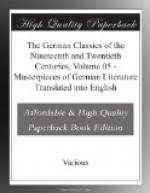Here nothing outward remains, with separate natural force; everything expresses receptivity and still endurance, even the perishable flesh, the character of which the Italian language designates by the term morbidezza, altogether unlike that with which Raphael invests the descending Queen of Heaven, as she appears to the adoring pope and a saint.
Though the remark be well-founded, that the original of Guido’s female heads is the Niobe of antiquity, yet the ground of this similarity is surely no mere intentional imitation; perhaps a like aim led to like means.
As the Florentine Niobe is an extreme in Sculpture, and the representation in it of the Soul, so this well-known picture is an extreme in Painting, which here ventures to lay aside even the requisite of shade and the obscure, and to work almost with pure Light.
Even though it might be permitted to Painting, from its peculiar nature, to give a distinct preponderance to the Soul, yet theory and instruction will do best constantly to aim at that original Centre, whence alone Art may be produced ever anew; whereas, at the stage last mentioned, it must necessarily stand still, or degenerate into cramped mannerism. For even that higher passion is opposed to the idea of having reached the acme of energy, whose image and reflex Art is called upon to display.
A right intelligence will ever enjoy seeing a creature worthily, and, as far as possible, also individually, represented; yea, Deity itself would look down with pleasure on a being that, gifted with a pure soul, should stoutly assert the dignity of its nature outwardly also, and by its sensually efficient existence.
We have seen how the work of Art, springing up out of the depths of Nature, begins with determinateness and limitation, unfolds its inward plenitude and infinity, is finally transfigured in Grace, and at last attains to Soul. But we can conceive only in detail what, in the creative act of mature Art, is but one operation. No theory and no rules can give this spiritual, creative power. It is the pure gift of Nature, which here, for the second time, makes a close; for, having fully actualized herself, she invests the creature with her creative energy. But as, in the grand progress of Art, these different stages appeared successively, until, at the highest, all joined in one; so also, in particulars, sound culture can spring up only where it has unfolded itself regularly from the germ and root to the blossom.
The requirement that Art, like everything living, should commence from the first rudiments, and, to renew its youth, constantly return to them, may seem a hard doctrine to an age that has so often been assured that it has only to take from works of Art already in existence the most consummate Beauty, and thus, as at a step, to reach the final goal. Have we not already the Excellent, the Perfect? How then should we return to the rudimentary and unformed?




